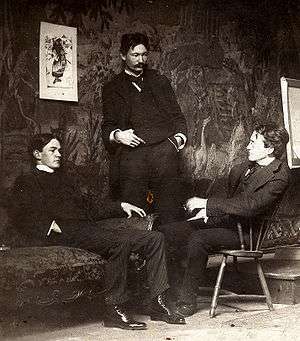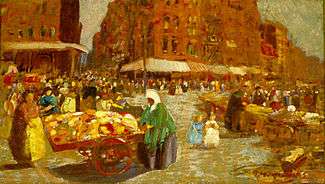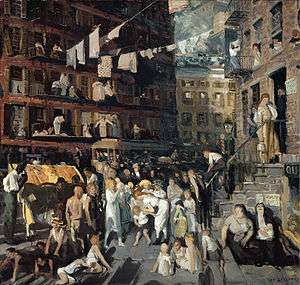Ashcan School

The Ashcan School, also called the Ash Can School, was an artistic movement in the United States during the early twentieth century that is best known for works portraying scenes of daily life in New York, often in the city's poorer neighborhoods. The most famous artists working in this style included Robert Henri (1865–1929), George Luks (1867–1933), William Glackens (1870–1938), John Sloan (1871–1951), and Everett Shinn (1876–1953), some of whom had met studying together under the renowned realist Thomas Anshutz at the Pennsylvania Academy of the Fine Arts, and others of whom met in the newspaper offices of Philadelphia where they worked as illustrators. Other artists modeling themselves after this movement included Merton Clivette who used the Chiaroscuro style in both light and dark juxtapositions and loose but forceful brushwork.[1]
Origin and development

The Ashcan School was not an organized movement. The artists who worked in this style did not issue manifestos or even see themselves as a unified group with identical intentions or career goals. Some were politically minded, and others were apolitical. Their unity consisted of a desire to tell certain truths about the city and modern life they felt had been ignored by the suffocating influence of the Genteel Tradition in the visual arts. Robert Henri, in some ways the spiritual father of this school, "wanted art to be akin to journalism... he wanted paint to be as real as mud, as the clods of horse-shit and snow, that froze on Broadway in the winter."[2] He urged his younger friends and students to paint in the robust, unfettered, ungenteel spirit of his favorite poet, Walt Whitman, and to be unafraid of offending contemporary taste. He believed that working-class and middle-class urban settings would provide better material for modern painters than drawing rooms and salons.
Many of the most famous Ashcan works were painted in the first decade of the century at the same time in which the realist fiction of Stephen Crane, Theodore Dreiser, and Frank Norris was finding its audience and the muckraking journalists were calling attention to slum conditions.[3] The first known use of the term "ash can art" is credited to artist Art Young in 1916.[4] The term by that time was applied to a large number of painters beyond the original "Philadelphia Five," including George Bellows, Glenn O. Coleman, Jerome Myers, Gifford Beal, Eugene Higgins, Carl Springchorn, and Edward Hopper. (Despite his inclusion in the group by some critics, Hopper rejected their focus and never embraced the label; his depictions of city streets were painted in a different spirit, "with not a single incidental ashcan in sight.")[5] Photographers like Jacob Riis and Lewis Hine were also discussed as Ashcan artists. Like many art-historical terms, "Ashcan art" has sometimes been applied to so many different artists that its meaning has become diluted.
The artists of the Ashcan School rebelled against both American Impressionism and academic realism, the two most respected and commercially successful styles in the United States at the end of the nineteenth century and the beginning of the twentieth century. In contrast to the highly polished work of artists like John Singer Sargent, William Merritt Chase, Kenyon Cox, Thomas Wilmer Dewing, and Abbott Thayer, Ashcan works were generally darker in tone and more roughly painted. Many captured the harsher moments of modern life, portraying street kids (e.g., Henri's Willie Gee and Bellows' Paddy Flannagan), prostitutes (e.g., Sloan's The Haymarket and Three A.M.), alcoholics (e.g., Luks' The Old Duchess), indecorous animals (e.g., Luks' Feeding the Pigs and Woman with Goose), subways (e.g., Shinn's Sixth Avenue Elevated After Midnight), crowded tenements (e.g., Bellows' Cliff Dwellers), washing hung out to dry (Shinn's The Laundress), boisterous theaters (e.g., Glackens' Hammerstein's Roof Garden and Shinn's London Hippodrome), bloodied boxers (e.g., Bellows' Both Members of the Club), and wrestlers on the mat (e.g., Luks' The Wrestlers). It was their frequent, although not exclusive, focus upon poverty and the gritty realities of urban life that prompted some critics and curators to consider them too unsettling for mainstream audiences and collections.
The advent of modernism in the United States spelled the end of the Ashcan school's provocative reputation. With the Armory Show of 1913 and the opening of more galleries in the 1910s promoting the work of Cubists, Fauves, and Expressionists, Henri and his circle began to appear tame to a younger generation. Their rebellion was over not long after it had begun. It was the fate of the Ashcan realists to be seen by many art lovers as too radical in 1910 and, by many more, as old-fashioned by 1920.
Connection to "The Eight"
The Ashcan school is sometimes linked to the group known as "The Eight," though in fact only five members of that group (Henri, Sloan, Glackens, Luks, and Shinn) were Ashcan artists. The other three – Arthur B. Davies, Ernest Lawson, and Maurice Prendergast – painted in a very different style, and the exhibition that brought "The Eight" to national attention took place in 1908, several years after the beginning of the Ashcan style. However, the attention accorded the group's well-publicized exhibition at the Macbeth Galleries in New York 1908 was such that Ashcan art gained wider exposure and greater sales and critical attention than it had known before.
The Macbeth Galleries exhibition was held to protest the restrictive exhibition policies of the powerful, conservative National Academy of Design and to broadcast the need for wider opportunities to display new art of a more diverse, adventurous quality than the Academy generally permitted. When the exhibition closed in New York, where it attracted considerable attention, it toured Chicago, Toledo, Cincinnati, Indianapolis, Pittsburgh, Bridgeport, and Newark in a traveling show organized by John Sloan.[6] Reviews were mixed, but interest was high. ("Big Sensation at the Art Museum, Visitors Join Throng Museum and Join Hot Discussion," one Ohio newspaper noted.)[7] As art historian Judith Zilczer summarized the venture, "In taking their art directly to the American public, The Eight demonstrated that cultural provincialism in the United States was less pervasive than contemporary and subsequent accounts of the period had inferred."[8] Sales and exhibition opportunities for these painters increased significantly in the ensuing years.
Gallery
-

Ashcan School artists, c. 1896, left to right, Everett Shinn, Robert Henri, John French Sloan
-

Thomas Pollock Anshutz, The Farmer and His Son at Harvesting, 1879. Five members of the Ashcan School studied with him, but went on to create quite different styles.
-

Robert Henri, Snow in New York, 1902, National Gallery of Art, Washington, DC
-
Everett Shinn, Cross Streets of New York, 1899, Corcoran Gallery of Art, Washington, DC.
-
William Glackens, Italo-American Celebration, Washington Square, 1912, Boston Museum of Fine Arts
-

George Luks, Houston Street, 1917, oil on canvas, Saint Louis Art Museum
-

Edward Hopper, The El Station, 1908, Whitney Museum of American Art
-

George Bellows, Cliff Dwellers, 1913, oil on canvas. Los Angeles County Museum of Art
-

George Bellows, Both Members of This Club, 1909, National Gallery of Art. Bellows was a close associate of the Ashcan school.
-

Jacob Riis, Bandit's Roost, 1888, (photo), considered the most crime-ridden, dangerous part of New York City.
-
.jpg)
Arthur B. Davies, Elysian Fields, oil on canvas, The Phillips Collection Washington, DC.
-

Maurice Prendergast, Central Park, New York, 1901, Whitney Museum of American Art
See also
Notes
- ↑ Hellman, George S.; Sterne, Maurice; New Gallery (New York, N.Y.), "Clivette : exhibition of paintings January 11 to 29, 1927", the New Gallery 600 Madison Ave., New York, 1927
- ↑ Robert Hughes, American Visions BBC-TV series
- ↑ Sam Hunter, Modern American Painting and Sculpture (New York: Dell, 1959), 28–40.
- ↑ John Loughery, John Sloan: Painter and Rebel (New York: Henry Holt, 1997), pp. 218–19
- ↑ Wells, Walter, Silent Theater: The Art of Edward Hopper (London/New York: Phaidon, 2007).
- ↑ Loughery, p. 127, 134–140.
- ↑ Loughery, p. 135.
- ↑ Judith Zilczer, "The Eight on Tour," American Art Journal, 16, no. 3 (Summer 1984), p. 38.
Sources
- Brown, Milton. American Painting from the Armory Show to the Depression. Princeton: Princeton University Press, 1955.
- Brooks, Van Wyck. John Sloan: A Painter's Life. New York: Dutton, 1955.
- Doezema, Marianne. George Bellows and Urban America. New Haven: Yale University Press, 1992.
- Glackens, Ira. William Glackens and the Ashcan School: The Emergence of Realism in American Art. New York: Crown, 1957.
- Homer, William Innes. Robert Henri and His Circle. Ithaca: Cornell University Press, 1969.
- Hughes, Robert. American Visions: The Epic Story of Art in America. New York: Knopf, 1997.
- Hunter, Sam. Modern American Painting and Sculpture. New York: Dell, 1959.
- Kennedy, Elizabeth (ed.). The Eight and American Modernisms. Chicago: University of Chicago Press, 2009.
- Loughery, John. John Sloan: Painter and Rebel. New York: Henry Holt, 1997. ISBN 0-8050-5221-6
- Perlman, Bennard (ed.), introduction by Mrs. John Sloan. Revolutionaries of Realism: The Letters of John Sloan and Robert Henri. Princeton: Princeton University Press, 1997.
External links
- Documenting the Gilded Age: New York City Exhibitions at the Turn of the 20th Century A New York Art Resources Consortium project. Exhibition catalogs, checklists, and photoarchive material.
| Wikimedia Commons has media related to Ashcan School. |

